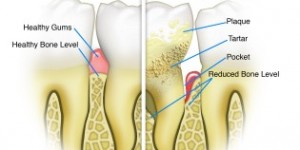 Under certain conditions, the gums can shrink, eventually exposing the roots of the teeth and making the crowns of the teeth appear longer than normal. This condition is known as gum recession, and it can be painful and increase a patient’s risk of cavities or even tooth or bone loss.
Under certain conditions, the gums can shrink, eventually exposing the roots of the teeth and making the crowns of the teeth appear longer than normal. This condition is known as gum recession, and it can be painful and increase a patient’s risk of cavities or even tooth or bone loss.
Periodontal disease (AKA gum disease) is often the culprit behind recession. In some people bacteria trigger an immune response causing periodontitis which eats away at gum tissue, causing it to pull away from the original gumline. Those bacteria can then collect in pockets that develop in the gums, causing further damage which may even extend to the bone. Additionally, the pattern of recession may be uneven.
If the patient seeks help in a timely fashion, the periodontist can address gum disease at its earliest stage, before it gets to the stage at which recession develops. So seeking prompt care can cut their chances of recession.
Periodontal disease (AKA gum disease) is often the culprit behind recession.
A periodontist can treat gum recession with a gum graft. In this procedure, donor tissue is taken from elsewhere in the mouth, such as the palate, or from a tissue bank, and sutured into the area of insufficient gum tissue.
After a gum graft surgery, your periodontist will give you instructions for self-care to maintain the good results and keep further periodontal disease at bay.
Periodontal disease is the most common cause of gum recession but not the only one. A person’s genes may dictate thinner than normal gums, and in these cases, patients are more susceptible to recession. Overly aggressive brushing techniques and bruxism, or grinding of the teeth, can also contribute to the problem, as can smoking. If you are a smoker, you will be encouraged to give up your cigarettes.
An orthodontist may recommend gum grafting before or after orthodontic treatment depending on several factors including, the type of orthodontic treatment, the severity of recession and how thick the existing gum tissue is.
Because hormonal changes have also been implicated in gum problems, women may face a greater risk of recession at times of fluctuation, such as pregnancy and menopause.
Patients who develop gum recession will notice that their teeth become more sensitive, as the exposed roots do not have the same protective enamel coating as the crowns of the teeth.
In order to prevent this problem, along with the other negative outcomes of gum recession, contact the office of Drs. Susan Karabin and Edward Gottesman, serving Manhattan’s Upper East Side, for treatment. Call 212-756-8890 to schedule your visit.


